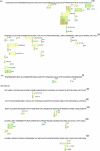HLA class I-driven evolution of human immunodeficiency virus type 1 subtype c proteome: immune escape and viral load
- PMID: 18434400
- PMCID: PMC2447109
- DOI: 10.1128/JVI.02455-07
HLA class I-driven evolution of human immunodeficiency virus type 1 subtype c proteome: immune escape and viral load
Abstract
Human immunodeficiency virus type 1 (HIV-1) mutations that confer escape from cytotoxic T-lymphocyte (CTL) recognition can sometimes result in lower viral fitness. These mutations can then revert upon transmission to a new host in the absence of CTL-mediated immune selection pressure restricted by the HLA alleles of the prior host. To identify these potentially critical recognition points on the virus, we assessed HLA-driven viral evolution using three phylogenetic correction methods across full HIV-1 subtype C proteomes from a cohort of 261 South Africans and identified amino acids conferring either susceptibility or resistance to CTLs. A total of 558 CTL-susceptible and -resistant HLA-amino acid associations were identified and organized into 310 immunological sets (groups of individual associations related to a single HLA/epitope combination). Mutations away from seven susceptible residues, including four in Gag, were associated with lower plasma viral-RNA loads (q < 0.2 [where q is the expected false-discovery rate]) in individuals with the corresponding HLA alleles. The ratio of susceptible to resistant residues among those without the corresponding HLA alleles varied in the order Vpr > Gag > Rev > Pol > Nef > Vif > Tat > Env > Vpu (Fisher's exact test; P < or = 0.0009 for each comparison), suggesting the same ranking of fitness costs by genes associated with CTL escape. Significantly more HLA-B (chi(2); P = 3.59 x 10(-5)) and HLA-C (chi(2); P = 4.71 x 10(-6)) alleles were associated with amino acid changes than HLA-A, highlighting their importance in driving viral evolution. In conclusion, specific HIV-1 residues (enriched in Vpr, Gag, and Rev) and HLA alleles (particularly B and C) confer susceptibility to the CTL response and are likely to be important in the development of vaccines targeted to decrease the viral load.
Figures



References
-
- Allen, T. M., M. Altfeld, X. G. Yu, K. M. O'Sullivan, M. Lichterfeld, S. Le Gall, M. John, B. R. Mothe, P. K. Lee, E. T. Kalife, D. E. Cohen, K. A. Freedberg, D. A. Strick, M. N. Johnston, A. Sette, E. S. Rosenberg, S. A. Mallal, P. J. Goulder, C. Brander, and B. D. Walker. 2004. Selection, transmission, and reversion of an antigen-processing cytotoxic T-lymphocyte escape mutation in human immunodeficiency virus type 1 infection. J. Virol. 787069-7078. - PMC - PubMed
-
- Altfeld, M., M. M. Addo, R. Shankarappa, P. K. Lee, T. M. Allen, X. G. Yu, A. Rathod, J. Harlow, K. O'Sullivan, M. N. Johnston, P. J. Goulder, J. I. Mullins, E. S. Rosenberg, C. Brander, B. Korber, and B. D. Walker. 2003. Enhanced detection of human immunodeficiency virus type 1-specific T-cell responses to highly variable regions by using peptides based on autologous virus sequences. J. Virol. 777330-7340. - PMC - PubMed
-
- Altfeld, M., T. M. Allen, E. T. Kalife, N. Frahm, M. M. Addo, B. R. Mothe, A. Rathod, L. L. Reyor, J. Harlow, X. G. Yu, B. Perkins, L. K. Robinson, J. Sidney, G. Alter, M. Lichterfeld, A. Sette, E. S. Rosenberg, P. J. Goulder, C. Brander, and B. D. Walker. 2005. The majority of currently circulating human immunodeficiency virus type 1 clade B viruses fail to prime cytotoxic T-lymphocyte responses against an otherwise immunodominant HLA-A2-restricted epitope: implications for vaccine design. J. Virol. 795000-5005. - PMC - PubMed
-
- Barouch, D. H., J. Kunstman, J. Glowczwskie, K. J. Kunstman, M. A. Egan, F. W. Peyerl, S. Santra, M. J. Kuroda, J. E. Schmitz, K. Beaudry, G. R. Krivulka, M. A. Lifton, D. A. Gorgone, S. M. Wolinsky, and N. L. Letvin. 2003. Viral escape from dominant simian immunodeficiency virus epitope-specific cytotoxic T lymphocytes in DNA-vaccinated rhesus monkeys. J. Virol. 777367-7375. - PMC - PubMed
Publication types
MeSH terms
Substances
Grants and funding
- AI061734/AI/NIAID NIH HHS/United States
- P01 AI061734/AI/NIAID NIH HHS/United States
- AI11514/AI/NIAID NIH HHS/United States
- AI067077/AI/NIAID NIH HHS/United States
- N01-AI-15422/AI/NIAID NIH HHS/United States
- R37 AI047734/AI/NIAID NIH HHS/United States
- R01 AI058894/AI/NIAID NIH HHS/United States
- P30 AI027757/AI/NIAID NIH HHS/United States
- AI058894/AI/NIAID NIH HHS/United States
- R01 AI067077/AI/NIAID NIH HHS/United States
- AI27757/AI/NIAID NIH HHS/United States
- R01 AI047734/AI/NIAID NIH HHS/United States
- G0500384/MRC_/Medical Research Council/United Kingdom
- AI047734/AI/NIAID NIH HHS/United States
- AI27005/AI/NIAID NIH HHS/United States
LinkOut - more resources
Full Text Sources
Medical
Molecular Biology Databases
Research Materials

